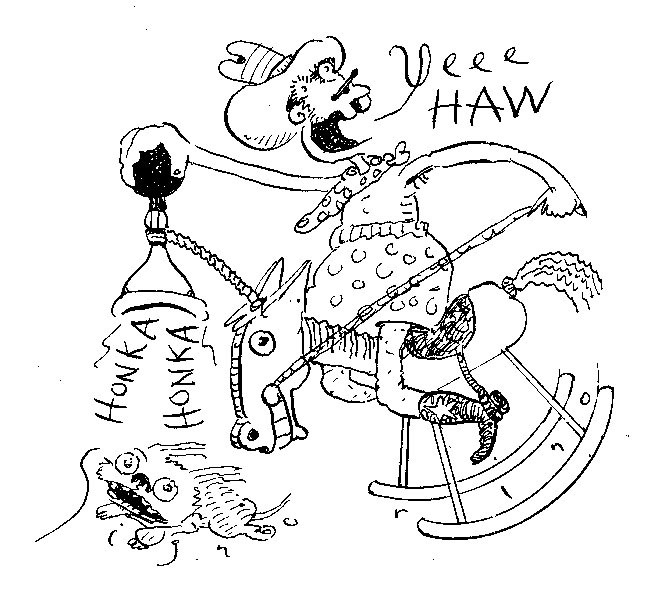
Out of the thousands of different ungulate species on this planet, horses are among the very few that have neither horns nor antlers. Obviously the development of such bony headwear conveyed a distinct evolutionary advantage to the other fleet-footed herbivores, so how did horses manage to evolve and survive without them?
—Cowboy Ken
Whoa up there, Ken. Yes, horses are ungulates—literally, hoofed mammals—and so are all those horn- and antler-bearing herbivores you're picturing. But past that you're on the wrong trail. Plenty of ungulates besides horses don't have horns, dozens of species historically classified as ungulates don't even have hoofs, and horses aren't as closely related to many of their horned kin as one might think to look at them.
When 19th-century taxonomists were sorting out the animal kingdom, they tossed horses into the biological order Ungulata along with the cattle, deer, et al. on the not-crazy assumption that their hoofs (ungulae, in Latin) and overall leg structure were evidence of kinship. But the fossil record soon complicated matters. Paleontologists did discover evidence of a common ancestor for all critters with hoofs or hooflike nails—but that same ancestor, it appeared, had also evolved into a lot of other things including dolphins, meaning the ungulate concept had to expand beyond hoofs, and even feet. Later, DNA research revealed genetic similarities between seemingly unlike species, scrambling classification systems still further; elephants and manatees, once counted among the ungulates, got bumped into a more distant grouping. The experts are still arguing about what species go where (one genome-based proposal from 2006 put horses in a group with cats, dogs and bats), but the current understanding says deer and antelopes are more closely related to whales than they are to horses.
But save the whales for another day; for now we'll stick with true ungulates, plant-eating quadrupeds with hoofs or something like them. These are grouped into two orders, the artiodactyls and the perissodactyls, that have evolved in parallel for more than 50 million years. Artiodactyls have an even number of toes (think cloven hoofs); they include sheep, goats, cows, deer and antelopes—i.e., basically all the horned creatures you can think of—but also pigs, hippos, camels and llamas, and a few others. Perissodactyls, with an odd number of toes, fall into three subgroups: horses and their cousins, the asses and zebras; tapirs, which don't have horns either; and rhinoceroses.
So the question isn't why horses don't have horns, but instead why, unlike their closest relatives, rhinos do. Let's go way, way back to Cambaytherium thewissi, a mammal whose fossilized remains, disinterred in India in 2014 and dated at 55 million years old, are thought to be the closest we've yet seen to the perissodactyls' common ancestor. This pig-sized beast had five toelike appendages per foot, no hoofs, and—sorry to disappoint anyone still holding out hope for evidence of ancient unicornsno horn. Sometime after that, horses and rhinos parted ways.
Early rhinos thrived in a variety of hornless forms, resembling modern tapirs or hippos or pudgy horses. Some grew to immense proportions (15-plus feet tall, 20 tons), the better to browse on tree leaves, until elephants edged them out of their habitat. The rhinos that ultimately made the cut stayed closer to the ground, ate grass, and along the way developed one or more horns. Unlike the headgear of the even-toed ungulates, rhino horns sprout from just above the nose rather than from the sides of the forehead, and consist solely of keratin, the stuff that makes up fingernails and sheathes the bony core inside the horns of cattle, antelopes, etc. (Antlers are constructed along different lines: They're all bone, and grow in a single two-sided unit from the front of the head.)
Meanwhile, the proto-horse called eohippus was making its way through the wild. This guy was around two feet tall with some complicated stuff going on down at the extremities: four toes on the front feet, three on the hind feet, each toe ending in its own small hoof. Once out on the plains, its descendants eventually became the horse we recognize today, as the need to escape carnivores rewarded more streamlined hoofs and a longer stride.
Whatever other obvious benefit they confer—African rhinos are huge and mean enough that they have no natural predators—horns play a notable role when rhinos, largely solitary otherwise, convene for courtship and mating; the males' horns are used not so much to lure the ladies (as with deer) but to use in sparring with rivals. Horses, by contrast, have evolved to live in herds, with well-defined hierarchies governing mating.
Natural selection didn't always go easy on horses. They died out in North America before being reintroduced in domesticated form by Europeans, and it's hard to see how horns would have helped them survive the food shortages brought about by climate change in the late Pleistocene era. Back here in the present, humans have become a factor in the ongoing development of rhinos, whose horns continue to attract the poachers that have already wiped out certain subspecies. A hornless rhino, you have to think, might have a better shot at survival.
Send questions to Cecil via StraightDope.com or write him c/o Chicago Reader, 350 N. Orleans, Chicago 60654.